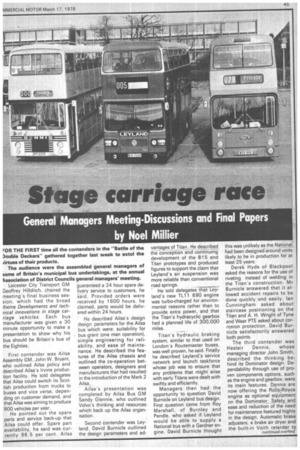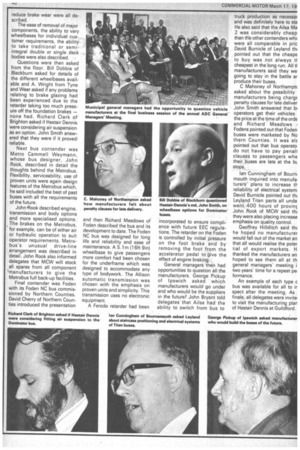Stage earn
Page 47

Page 48

If you've noticed an error in this article please click here to report it so we can fix it.
General Managers Meeting-Discussions and Final Papers by Noel Millier
FOR THE FIRST time all the contenders in the "Battle of the 3ouble Deckers" gathered together last week to extol the rirtues of their products.
The audience were the assembled general managers of some of Britain's municipal bus undertakings, at the annual Ilissociation of District Councils general managers' meeting.
Leicester City Transport GM guaranteed a 24 hour spare de Geoffrey Hil'ditch, chaired the livery service to customers, he meeting's final business session, which had the broad theme Developments and technical innovations in stage carriage vehicles. Each bus manufacturer was given a 30 minute opportunity to make a presentation to show why his bus should be Britain's bus of the Eighties.
First contender was Ailsa Assembly GM, John W. Bryant, who outlined Ailsa policy and described Ailsa's Irvine production facility. He told delegates that Ailsa could switch its Scottish production from trucks to buses and vice versa, depending on customer demand, and that Ailsa was aiming to produce 900 vehicles per year.
He pointed out the spare parts and service back-up that Ailsa could offer. Spare part availability, he said was currently 96.5 per cent. Ailsa said. Provided orders were received by 1600 hours, he claimed, parts would be delivered within 24 hours.
He described Ailsa's design design parameters for the Ailsa bus which were: suitability for bus grant (one man operation), simple engineering for reliability, and ease of maintenance. He described the features of the Ailsa chassis and outlined the co-operation between operators, designers and manufacturers that had resulted in the introduction of the Mark 2 Ailsa.
Ailsa's presentation was completed by Ailsa Bus GM Sandy Glennie, who outlined Volvo's thinking and resources which back up the Ailsa organisation.
Second contender was Leyland. David Burnicle outlined the design parameters and ad
vantages of Titan He described the conception and continuing development of the B15 and Titan prototypes and produced figures to support the claim that Leyland's air suspension was more reliable than conventional road springs.
He told delegates that Leyland's new TL11 690 engine was turbo-charged for environmental reasons rather than to provide extra power, and that The Titan's hydracyclic gearbox had a planned life of 300,000 miles.
Titan's hydraulic braking system, similar to that used on London's Routemaster buses, was well proven, he said. Finally he described Leyland's service network and launch taskforce whose job was to ensure that any problems that might arise with early Titans were dealt with swiftly and efficiently.
Managers then had the opportunity to question David Burnicle on Leyland bus design. First question came from Roy Marshall, of Burnley and Pendle, who asked if Leyland would be able to supply a National bus with a Gardner engine. David Burnicle thought this was unlikely as the National had been designed around units likely to be in production for at least 25 years.
Derek Hyde of Blackpool asked the reasons for the use of riveting instead of welding in the Titan's construction. Mr Burnicle answered that it allowed accident repairs to be done quickly and easily. Ian Cunningham asked about staircase positioning on the Titan and A. H. Wright of Tyne and Wear PTE asked about corrosion protection. David Burnicle satisfactorily answered both points.
The third contender was Hestair Dennis, whose managing director John Smith, described the thinking be-, hind its Dominator design. Dependability through use of proven components options, such as the engine and gearbox, were its main features. Dennis are now offering the Rolls-Royce engine as optional equipment on the Dominator. Safety and ease and reduction of the need for maintenance featured highly in the design. Automatic brake adjusters, a brake air dryer and the built-in Voith retarder to reduce brake wear were all described.
The ease of removal of major components, the ability to vary wheelbases for individual customer requirements, the ability to take traditional or semiintegral double or single deck bodies were also described.
Questions were then asked from the floor. Bill Dobbie of Blackburn asked for details of the different wheelbases available and A. Wright from Tyne and Wear asked if any problems relating to brake glazing had been experienced due to the retarder taking too much pressure off the foundation brakes — none had. Richard Clark of Brighton asked if Hestair Dennis. were considering air suspension as an option. John Smith answered that they were if it provedl reliable.
Next bus contender was Metro Cammell Weymann, whose bus designer, John Rook, described in detail the thoughts behind the Metrobus. Flexibility, serviceability, use of proven units were again design features of the Metrobus which, he said included the best of past buses with all the requirements of the future.
John Rook described engine, transmission and body options and more specialised options. The brakes on the Metrobus, for example, can be of either air or hydraulic operation to suit operator requirements. Metrobus's unusual drive-line arrangement was described in detail. John Rook also informed delegates that MCW will stock all spares from all component 'manufacturers to give the Metrobus full back-up facilities.
Final contender was Foden with its Foden NC bus commissioned by Northern Counties. David Cherry of Northern Counties introduced the presentation and then Richard Meadows of Foden described the bus and its development to date. The Foden NC bus was designed for long life and reliability and ease of maintenance. A 5.1m {16ft 9in) wheelbase to give passengers more comfort had been chosen for the underframe which was designed to accommodate any type of bodywork. The Allison automatic transmission was chosen with the emphasis on proven units and simplicity. This transmission uses no electronic equipment.
A Ferodo retarder had been incorporated to ensure compliance with future EEC regulations. The retarder on the Foden is controlled by initial pressure on the foot brake and by removing the foot from the accelerator pedal to give the effect of engine braking.
General managers then had opportunities to question all the manufacturers. George Pickup of Ipswich asked which manufacturers would go under and who would be the suppliers in the future? John Bryant told delegates' that Ailsa had the ability to switch from bus to truck production as necessar and was definitely here to sta He also said that the Ailsa Ma 2 was considerably cheap than the other contenders whii were all comparable in pric David Burnicle of Leyland thi pointed out that the cheape to buy was not always tl cheapest in the long run. All ti manufacturers said they we going to stay in the battle ar produce their buses.
C Mahoney of Northamptc asked about the possibility manufacturers being chargE penalty clauses for late deliver John Smith answered that bi operators get their vehicles the price at the time of the ordE and Richard Meadows Fodens pointed out that Foden buses were marketed by No them Counties. It was alE pointed out that bus operato do not have to pay penall clauses to passengers whe their buses are late at the bc stops,
Ian Cunningham of Bourn. mouth inquired into manufa. turers' plans to increase th reliability of electrical system David Burnicle pointed out thi Leyland Titan parts all unde went 400 hours of provinc. John Rook of MCW said thi they were also placing increase emphasis on quality control.
Geoffrey Hillditch said thE he hoped no manufacturer would fall out of the market an that all would realise the poter tial of export markets. H thanked the manufacturers an hoped to see them all at th general managers' meeting i two years' time for a repeat pa formance.
An example of each type c bus was available for all to ir spect after the meeting. As finale, all delegates were invite to visit the manufacturing plar of Hestair Dennis at Guildford.
























































































































